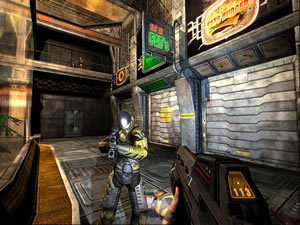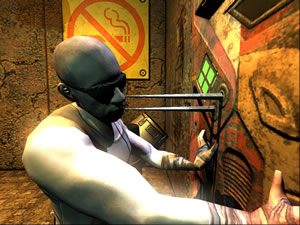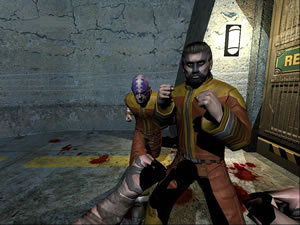This jailhouse rocks.
Game journalists have a Pavlovian response to games based on movies. Within moments of witnessing such a licensed property, ours chests tighten, our mouths dry up, and, if left unchecked, our eyes might very well bleed. You can’t blame us; after years of terrible licensed game after terrible licensed game, avoiding such dreck has become as instinctual as not jumping into a fire every time you light one.
But there are exceptions to every rule, the latest of which is the surprisingly good The Chronicles of Riddick: Escape From Butcher Bay. Unlike most games related to a film franchise, Escape
From Butcher Bay is not technically based on a movie. Rather, it functions as a prequel to the other two Riddick films, the cult hit Pitch Black and the new movie The Chronicles of Riddick. Perhaps that’s why this game bucks the trend and serves up a solid first-person stealth/action experience.
The Butcher
Bay story lacks a concrete beginning or end, feeling more like a chapter in the saga of Richard B. Riddick, which I guess is fitting for a game that takes place as part of a chronicle. The only insight into Riddick’s origin is provided by his renown among the Butcher Bay prisoners; even these bad-asses fear the guy. But as tough as Riddick may seem, he’s been captured by the bounty hunter Johns, and is being sold into incarceration for the cancellation of a debt owed to the Warden.
While Johns’ ship is preparing to land, Riddick has a dream that acts as a subtle tutorial. In the dream, Riddick kills Johns and tries to escape from the prison. Throughout this short sequence, the player gets cues from Riddick and short explanations of his abilities. For example, as Riddick passes through a doorway into a dark area he’ll say something along the lines of ‘No one will see me now,’ which is accompanied by a dialogue box explaining crouching/shadows and the general stealth mechanics of the game.
Even though formalities such as tutorials, dialogue boxes and life-bars are essential to video games, the developers did a great job emphasizing the cinematic qualities of Escape
From Butcher Bay by getting rid of the HUD. What Riddick sees is what you see. If you look down, you see your legs and/or shadow. When you jump, you see your hands move to balance you. Riddick does have a life bar, although it’s only visible during combat situations or when the player makes it so by pressing the ‘X’ button. The result is highly immersive.
Unfortunately, Escape From Butcher Bay‘s similarity to a film extends to its linearity. There are two short episodes that are open-ended and non-linear, but most of the game involves skulking through a room or down a corridor and killing whatever you come across in order to get to the next checkpoint save. Also, the plot threads introduced in these sequences never go anywhere. You never see any of the prisoners you speak to later, so there is no sense of plot continuity at all.
But in all honesty, this doesn’t really get in the way of the terrific gameplay. Escape
From Butcher Bay is played entirely from a first-person perspective, except when Riddick does something like climb a crate or kick out a grate. If Riddick is crouching and enters the shadows, his field of vision will assume a blue-tint, meaning guards cannot see him. And if Riddick is able to sneak up behind a guard, he can either grab the guard with and kill him silently or go for the quick, noisy kill.
 However, when killing simply isn’t an option, Riddick can use the environment
However, when killing simply isn’t an option, Riddick can use the environment
to his advantage by scaling walls, crawling through ducts and shimmying along
ledges. Even though Riddick’s maneuvering capabilities aren’t new or particularly
diverse, the environments are so realistic and well-conceptualized that creeping
through them never gets old. The only feature I really miss is the ability to
distract the guards. Riddick can’t whistle or throw things or bang on surfaces
to misdirect his enemies, making him less sneaky than he ought to be.
Since
Riddick is in prison, he normally has little in the way of weaponry apart from
his fists or a shiv. And since most of the guards are heavily armed, Riddick
has to be extremely careful in dispatching them. Fortunately, if discovered,
Riddick can still kick ass the old-fashioned way. Melee combat is handled exceptionally
well for a first-person game, including the ability to string together combos.
During melee combat, your enemies are wonderfully nuanced. All enemies use combos,
some are more aggressive than others, some punch faster than others, and all
take extremely realistic-looking damage to their faces. Whack an enemy with
a blunt object and the marks on their face are different than is you used something
sharp, like a screwdriver or scalpel. After landing a few solid blows, a big
hit will stagger your enemy, leaving him wide open. At this point you can land
big shot after big shot to quickly put your foe out of commission. The whole
thing works beautifully.
The gunplay isn’t quite as well-implemented as the fisticuffs. Riddick eventually finds a tranq-gun, a hand-gun, a shotgun, an assault rifle, and a mini-gun. However, the hit detection isn’t great; most enemies don’t seem to react to getting shot physically until they die. If you manage to get extremely close to an enemy and blast him with the shotgun, for example, you may notice a slight flinch rather than a satisfying lurch.
Also, the enemies aren’t the smartest lot. They aren’t stupid, but they never go through doors and frequently stand out in the open waiting for you to show yourself. They throw grenades, but only during scripted sequences. Not bad, but not Half-Life, either.
What’s so cool about the stealth/shooter mix is the way you’ll go from being entirely unarmed, to bristling with guns, to entirely unarmed again. After being a death-machine for a good hour, the player will have to readjust to discretion. This adds a sensation of helplessness and vulnerability to the stealth portions, as well as a feeling of euphoria when you finally get your hands on a good gun again.
 Part of that euphoria, though, might be attributed to the game’s outrageously good graphics. Using a cool new piece of tech called ‘normal-mapping,’ Escape
Part of that euphoria, though, might be attributed to the game’s outrageously good graphics. Using a cool new piece of tech called ‘normal-mapping,’ Escape
From Butcher Bay shows off some of the most stunningly realistic environments on the Xbox. The entire prison world is beautifully and fully conceptualized, from the sickly green and orange lighting to the cracks in the doors. Riddick himself looks exactly like Vin Diesel, which is creepy, though during the scenes when you can see yourself, things look a bit jagged. But thanks to the smooth framerate and lifelike animations, this game is sure to please even the most discriminating eyes.
Escape From Butcher Bay sounds terrific as well, mainly thanks
to Vin Diesel and his supporting cast of voice talent. Diesel’s voice is perfect
for video games, and his character manages to come off as bad-ass with a sense
of humor rather than an ass with a bad sense of humor. The most notable cast
member is Ron Perlman, who provides the role of Jagger Valance, yet this character
only speaks a handful of lines. The bulk of the game’s sound effects are absolutely
incredible, with blaring gun-fire, commanders barking orders through crackly
PA systems, and generally excellent ambient sounds. Even the score is good, although
parts of it sound lifted straight from Metal
Gear.
The Chronicles of Riddick: Escape from Butcher Bay is good for about 12-15 hours of compelling single-player gameplay, but unfortunately there isn’t much keeping you coming back for more. A few other difficulty settings are here alongside some unlockable movies and stills and whatnot, but that’s not much, and amazingly the game features no multiplayer at all. It’s a shame.
But despite the fact that The Chronicles of Riddick: Escape
From Butcher Bay is a somewhat short, linear romp with limited replayability,
it’s about as good as Xbox action gaming gets, from its fantastic delivery to
its fun combat. Definitely an escape worth taking.




